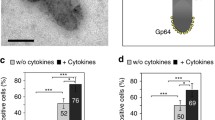Abstract
We have recently reported that local administration of anti-Fas monoclonal antibody (MAb) in human T cell leukemia virus type 1 (HTLV-1) carrying mice improved arthritis due to the induction of apoptosis. This finding strongly indicated the beneficial therapeutic effect of Fas-mediated apoptosis in rheumatoid arthritis (RA). To establish further the therapeutic effect of Fas-mediated apoptosis on RA taking into consideration safety and practicality, we investigated the effect of cells transfected with human Fas ligand (hFasL) gene on proliferating human rheumatoid synovium engrafted in severe combined immunodeficiency (SCID-RA) mice. The hFasL transfectants exhibited cytotoxic activity against RA synoviocytes via the Fas/FasL system in vitro. Histopathological and immunohistochemical studies showed that local injection of irradiated-hFasL transfectants eliminated synoviocytes and mononuclear cells in engrafted human rheumatoid synovium of SCID-RA mice. Furthermore, in situ nick end labeling analysis confirmed that the cells in engrafted synovium frequently underwent apoptosis by irradiated-hFasL transfectants. Our results clearly demonstrated that hFasL transfectants induced apoptosis by cell-to-cell interaction via the Fas/FasL system. Thus, ex vivo gene transfer of FasL may represent a novel therapeutic strategy for RA.
Similar content being viewed by others
Author information
Authors and Affiliations
Rights and permissions
About this article
Cite this article
Okamoto, K., Asahara, H., Kobayashi, T. et al. Induction of apoptosis in the rheumatoid synovium by Fas ligand gene transfer. Gene Ther 5, 331–338 (1998). https://doi.org/10.1038/sj.gt.3300597
Received:
Accepted:
Published:
Issue Date:
DOI: https://doi.org/10.1038/sj.gt.3300597
- Springer Nature Limited
Keywords
This article is cited by
-
Fas/FasL, Bcl2 and Caspase-8 gene polymorphisms in Chinese patients with rheumatoid arthritis
Rheumatology International (2016)
-
Anti-arthritic effects of FasL gene transferred intra-articularly by an inducible lentiviral vector containing improved tet-on system
Rheumatology International (2014)
-
Relation of the Fas and FasL gene polymorphisms with susceptibility to and severity of rheumatoid arthritis
Rheumatology International (2013)
-
Harnessing programmed cell death as a therapeutic strategy in rheumatic diseases
Nature Reviews Rheumatology (2011)
-
Elevated expression of caspase-3 inhibitors, survivin and xIAP correlates with low levels of apoptosis in active rheumatoid synovium
Arthritis Research & Therapy (2009)




